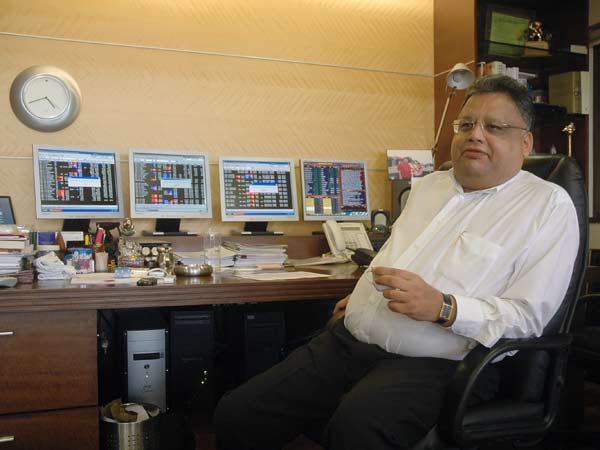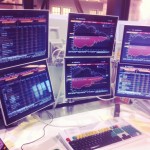
Rakesh Jhunjhunwala – An Inspiration, Role Model and the only best of all stock trader and investor we Indians know. The one who has transformed the way we see the trading world.
Its a story of inspiration of a young dreamer who started back in 1985 at the age of 25 years with limited capital of only Rs. 5000 but with big dreams, who spent day and night to understand the rules of the games, whose courage and dedication made him a billionaire & surely one of the most followed and respected investor / trader in India & across the globe. The one who broke all the fixed rules of trading and laid down the foundations for others to follow.
The one considered to be an idol figure, someone who has given light to the hope and dreams of all the young new comers to the trading world. Respected not anywhere less than Sachin Tendulkar who is considered to be the god of cricket in India.
We hereby HONOR another TRADING LEGEND as a God of Trading in India – Rakesh Jhunjhunwala.
How did Rakesh Jhunjhunwala started his journey in Indian Stock Market?
Beginning of a New Dreamer – Entering the Trading World
Rakesh Jhunjhunwala started his trading journey in 1985 at the age of 25 years right after completing his Chartered Accountancy (CA). He got the inclination to invest in the markets from his father who himself was an investor. When Rakesh asked his father that he wants to make a career in Stock Market his father gave him his blessings and supported him psychologically & emotionally but in turn ask him not to approach him and his friends for the capital.
So from the beginning he was clear that to trade or invest the market, he has to arrange the capital on his own. He started with his saved money of Rs. 5000 and got his funding of Rs. 2.5 lacks @ 18% interest rate and another Rs. 5 lacs from some other known at 24% from some of his and brothers known.
After arranging for some 8-10 lacs for trading, he started his trading career while standing outside the ring of Bombay Stock Exchange (BSE).
How Rakesh Jhunjhunwala make money from his first few investments?
Early Years in Trading Arena – Rise of the Investor
His First Investment Ever – Tata Power
In 1985, Rakesh Jhunjhunwala bought 5000 shares of Tata Power with a thought of companies good earnings & as the yield was greater than the interest. The stock gave him a regular dividend income flow of Rs. 40000-50000 per year. This is how rakesh jhunjhunwala generated the regular cash flow to meet his expenses during his earlier years in trading the markets.
He was living at his home where his father used to take care of all the home expenses so he was careful and conservative with his things as all that he had was saved in his investment in Tata Power. This made him feel that in to grow or compound his capital, the only passport for him is to Start Trading the Markets.
Rise of a Trader
First Leveraged Trade in Tata Motors in 1988
In his own words, I leveraged because I had no capital. The Badla trade or the Futures trade I did only in 1988 because I had earned money, I started with Rs 5000, by 1988 I had got Rs 70-80 lakh. My family won’t give me any capital. My father even if he gave I wouldn’t take, it is the costliest form of capital. So, I thought how do I get capital? I had Rs 70-80 lakh so I thought the only way I can get capital is by Trading.
So, he did his first forward (badla) trade in life.
Rakesh Jhunjhunwala bought 5 lac shares of Tata Motors @ Rs 90 and in four months he sold at 120 and he was worth another crore i.e. a total of 2 crore of investment capital now.
Next Transformed Trade – Sesa Goa
Some of his friend recommends him to buy Sesa Goa, the company owned by Anil Agarwal. He researched the company and the iron ore price and bought 2.5 lac shares @ Rs. 27-28 per share & another 2.5 Lac shares @ Rs. 35-36 per share so a total of 5 lac shares of Sesa Goa.
Before buying the stock, Rakesh Jhunjhunwala thought that the the price will reach Rs 60-65 in a year and he will sell. But as the Ruia’s wanted to get into iron ore & Citi Bank was buying for Ruia`s so the price flared up to Rs 65 in just three months. He sold 4 lac shares at Rs 60 & retained about 1 lac shares. This made his total net worth zoomed to Rs 4 crore.
The 1 lac shares of SesaGoa that he retained was sold in between till 1992 when the stock price zoomed up till Rs. 2200 per share.
Important Note:-
He bought next lot of 2.5 shares of Sesa Goa at a price higher than his initial purchase price. So, before betting on again in the stock, he must have waited for some confirmation for favorable situations as per his expectations in the rise of the iron ore prices and in-turn rise in the price of the stock.
Also, he sold back 80% of the stock bought at the price he decided to sell before buying the stock while retained some to go with the market conditions.
So, it becomes always necessary for a trader or a investor to buy more whenever situations and stock price moves as per your expectations and not against. And also to exit and book some profits inline with your expectancy while some quantities may be left over to keep on rolling as per the conditions.
I. Rakesh Jhunjhunwala as an Investor
Multi-Baggers in his Career
How to Find Multi Baggers?
One needs to check what opportunity the business has? who are the entrepreneurs? how much capital is needed? is the business scalable? and what is the company`s valuation?
It should not be one of the popular stocks. there should not be any institutional ownership, it should be under research, nobody should know about it.
Investing In What You Know the Best!
His Major Investment Ideas that Worked Well
How he spotted multi-baggers?
Titan Industries
Rakesh Jhunjhunwala has one of his biggest holdings in Titan Industries. He invested in titan some 14 years ago which generated him 8000+% return from his investments which is now worth some Rs. 2500 crores and accounts for more than 25% of his total investments in equities.
Rakesh Jhunjhunwala said my reason for investment in Titan Indsutries was because of the India`s macro as India was going to have a huge consumer market. Titan was a retailer, it was a brand company, it always had a great business. He said I thought branding business in jewellery will eventually succeed. I envisaged the future and I thought Indians are going to buy far many watches, so that is how the business should be great.
Jhunjhunwala bought into Titan in 2002-03 at an average price of around Rs 5; the stock then rose to touch Rs 80 and later fell to Rs 30, but he did not sell a single share. That Rs 30 is nearly Rs 375-400 today.
He investments in titan had an average price of Rs 32-33 and bought some 12.5 lac shares and thought that the price would become Rs 200-215 in five years. I never thought that the shares will be in four figures but once I met the management of Titan to understand what is within the core of the company I predicted that night that the price will eventually go in 4 figures and then I started buying further and I bought upto Rs 150-160.
His other Multi-bagger Investments
Rakesh Jhunjhunwala has held his other major disclosed stakes in nine companies, including Crisil, Lupin, Aurobindo Pharma. He has a dedicated disclosed portfolio of 8000+ crores, out of which his three holdings is more than half of the portfolio value where Titan accounts for approx 2500cr, Lupin 1250cr, and crisil 790 cr.
His 2nd biggest investment in held for a long time didnot went up more till 2009. The stock was in the Rs 135-150 range, but went up from Rs 150 to Rs 1,350 in 2015.
His average returns have been highest from the stocks he held the longest as his highest returns are on stocks he has held for at least 10 years such as Lupin with approx. returns of 13000%, Crisil 5000% and Titan 8000%.
EPS & P/E
Price is equal to EPS multiplies by P/E, so circumstance should arise where the P/E should grow and the EPS should grow. Suppose I buy a stock, which earns Rs 5. At 5 P/E and I pay Rs 25, if the earnings becomes Rs 15 and the P/E becomes Rs 20, that Rs 25 goes to Rs 300. So, the basic methodology is. P/E expansion is function of so many items. It is a function of size. So, many of my companies I don`t sell because I feel that P/E will expand, as their size increases and liquidity increases. In trading, I can do anything but am I going to invest at 60 times P/E, 70 times P/E. Definitely No.
When to Sell Multibaggers?
Multibaggers should be sold only in two circumstances: when we have limited capital and when we get an opportunity that is better than what we have now.
Secondly, when the perception of earnings peaks and the P/E is unsustainable. Its time to sell.
Read the story and investment philosophy of another great legend – Peter Lynch. He was the one who invented the word “Multibaggers”. Peter Lynch is one of the most admired and followed stock investor / fund manager. Lynch always outlined the advantage that a everyday investors has to spot good investments in their day-to-day lives and because of their familiarity with the market place. He is the author of the best selling investment books
Some one who always stresses on Investing In What You Know the Best! He said
Rakesh Jhunjhunwala`s Investment Style
#1. Invest Before you Investigate – If he find something great, he buys it & then do all the research.
Rakesh Jhunjhunwala said sometimes market gives us such great opportunity where you just buy the stock at the very first moment and then you investigate later.
Some of his investments like in Dewan Housing which had a Rs 230 book value, 6 percent yield, 4 times earnings. The company was growing at 20 percent for the last ten years and was available at Rs 105. He bought 50 lac shares and said to himself we will think about it later – it is trading at such ridiculous valuations.
Another case where he invested in Lupin not because he knew all the technicallities of the pharma like ANDA, DMF, etc but I knew one thing that Ranbaxy had earned Rs 250 crore in a single product. Similarly, Lupin had the only injectable Cephalospor in approved FDA plant in Asia. They were the single filer for a product having a size of USD 360 million and the marektcap of Lupin was Rs 200 crore. What is there to think?
So those kinds of situations for him are like INVEST NOW & INVESTIGATE LATER.
In one his interviews, he said the girl should be so pretty that you think of the consequences later, you first start dating her. The stock should be such that at this valuation let us just buy. Similar to situation like meeting Aishwarya Rai, what are you thinking!! You date her without thinking.
In an interview he said that he reads Economist and India Today. In the Economist, he read the entire business section and the science and technology section. These are the constant reads. He also reads the broker reports and go through balance sheets.
#2. Four Important factors for Investing in a Company
- The External Opportunity – Demand
- For instance in Praj maybe because of the need of alternative fuels the demand for ethanol plants went through the roof. So, I look at the opportunity the business has.
- India being a youth county, Companies like titan with products as FastTrack can attract a huge demand to meet.
- Entry barriers as he outlined In case of Titan whereby in jewelry business there are low margins, so there are entry barriers.
- Entrepreneurs
- Capital needed
- Valuations – It is important what you buy, it is important at what price you buy. So, I look at the valuations. Many companies do underperform or outperform the markets. So stock may rise many folds when the index is falling while it may fall when the over all markets are rising. So it becomes important to know and evaluate the right price of a stock to be bought. Because market may perform but it might happen that you stock will go no where.
When Rakesh Jhunjhunwala bought United breweries at the price of Rs 15-17, people warned you are buying Mr Mallya`s company, you will not earn anything. He calculated that for Rs 100 crore marekt cap, we were getting 60% of India`s liquor industry. So, it is important what you buy and it is more important what price you buy but that doesn`t mean that if Infosys has Rs 30 crore market capitalization, then at Rs 90 crore you should not buy it. We don`t buy it just because it has doubled. You have to see value when you buy.
#3. Believe In India
He is a strong believer in India`s growth story. Most of his investments are based on the growth of the Indian economy and centered around Indian Consumers. He said I think the most exciting thing that I find about Titan is not Tanishq but Fast Track. It is India`s biggest youth brand. If you look at the potential market, if you look at the marketing skills, it is unbelievable. all my companies are 98% India-centric. If India doesn`t grow @ 9-10%, Titan cannot grow at the price at which it is growing. So, the call is India.
#4. Never Avoid Unpopular Companies
For a multibagger pick, he believes that the stock should not be one of the popular ones.
- Never in my life have I not made an investment because the stock is not popular. In fact I like to make the investment when the stock is not popular.
- There should not be any institutional ownership, it should be under research, nobody should know about. Because if market will know about it, they will drive the stock price up.
- Most important is You Get it Cheap.
This supports his saying that – if the girl is pretty, the suitor will come. This happened when he got bullish on PSUs and people used to ignore him.
#5. Balancing Greed & Fear
A right balance between the greed and fear is utmost important not only for the growth of a trader or an investor but also for his survival in the markets. Any deviation between the two will put the trader or investor into big trouble. So, even if you are extremely bullish in a stock don`t be greedy by putting in more than certain percentage of the wealth into the stock and also fear will ensure that you don`t do such things by thinking that the stock might not do well and you may loose on your investments. But don`t let your fear or greed takes a heading play in your trading decisions.
I hold investments for a long time because I read somewhere and time has taught me that we should be greedy, but long term greedy. So, when you have something good, stick to it.
II. Rakesh Jhunjhunwala as a Trader
Someone asked him why you talk about trading when markets are all about Investing? For which he replied who will give you capital to invest? Your Father or My Father. So to build up capital to invest you have to opt for Trading. He actively trades in the market and always have a differentiated list of stocks he will be trading as against his investment bets.
In his words, I had no capital when I came to the markets, and no father gifts and no father-in-law gifts. So I had to earn the capital to invest. How do you invest if you don’t have the capital? And I got the capital by doing future trading.
Does Rakesh Jhunjhunwala actually trades the market or Leverage? Does he do short trades?
Below are some of his trades he shared.
I remember I was short 15,000 shares of ACC and at 4 o`clock in the afternoon Saturday, I called my broker and I said, Whatever be the price and whatever be the cost, I want 15,000 shares covered and then at Rs 3,000 I was long.
In 1998, Rakesh Jhunjhunwala he was worth 89-90 lacs. Started badla trading. Bought Tata Motors. Bought 5 lac shares at Rs. 90 and in four months he sold at 120. And he was worth another crore i.e. 2 crores in total.
In 2003, he bought Tata Motors @ Rs 240. He had a position of 2 million shares and when the stock was at Rs 340, he squared off everything.
The Bottom & Top Picker
In his own words,
I first earned on the budget, everyone was so bearish, I made money. We made money right at the point, we sold nearly at the top then we shorted the market during the Gulf war then we cut at the bottom. Then when Manmohan Singh became the Finance Minister, we bought lot of stocks.
Rakesh Jhunjhunwala Trading Style
#1. Never average a losing trade
#2. No Price is too High to Buy & No Price is too low to Sell
#3. Dont let your trades into Investments.
#4. Looking at the Broad Direction – Don`t try to be an expert or predict every move, every hour, every day. Take a loss, know what to stake. I think I feel confident to trade anywhere in the world or what you need to have is a broad direction of the trend and very broad ideas.
#5. Know what to stake and when to take a loss.
#6. Rule of Pyramiding – Go with the Trend of the Market – As a rule in trading, never ever average a losing position.
#7. Price is the first indicator? – We know all big moves start with small moves and therefore the price is the first indicator of what is coming.
#8. On Leveraging – I had no capital when I came to the markets, no father or father-in-law gifts. So, I had to earn the capital to invest and I got that capital by trading in the futures market.
#9. Follows what George Soros says – It`s not important that you are right or wrong in trading, its important how much you lose when you are wrong or how much you make when you are right.
#10. Going With the Trend – I always trade with price. If I would do a trade, so long my XYZ stock is at Rs 100 and it goes to Rs 120 and I buy more, no worry, by the time it will be Rs 90, we will all squared off. Its what we call as Vadhere Vadhare Levanu Vadhare Vadhare Beichavanu. Say I am bullish on XYZ stock I buy that stock, if it goes up it is an indication of the fact that I am right. We do what is called as pyramiding. I buy a stock at Rs 100, I buy more at Rs 105, I buy more at Rs 110 so what are markets, what it is trading? It is basically momentum, so you play momentum.
If the market is rising vadhere vadhare its momentum is upwards. You buy on the rise, if markets are going down, you sell on the fall. This applies to short term trends, medium term trends and long term trends.
Also, Read the story and trading rules of a Boy Trader who started trading the markets at the age of 14 and later became the Greatest Speculator of Wall Street.
How a 14 year Old Kid Transformed Himself to Become the Greatest Trader of the Wall Street?
What others have to say about Rakesh Jhunjhunwala?
When he talk trading, he talks as per rules of trading which are price, demand and supply driven and while for investing as per investment rules P/E, valuations, EPS, Sales, etc. So, he is able to differentiate well what he is doing? Trading or Investment. He never let his trades become his investments.
Why does Rakesh Jhunjhunwala require 4 Screens in his Trading Room to manage his Portfolio?
He said in an interview that all the screens are of the BSE, NSE live stock prices. Multiple screens help him to stay updated with all of his long term investments, short term investments, stock he is following, futures he trades and Reuters screen to get the market information.
Trading Lessons from Rakesh Jhunjhunwala for New Traders
#1. Be clear with whether you are trading or investing. Don`t let your trades into long term investments.
#2. Don`t sell the stock only on the basis of fundamentals and opinions but also account the market conditions.
#3. Put Money where your mouth is.
#4. Mistakes are your learning friend. The idea is to keep these mistakes small.
#5. If a girl is beautiful a suitor will come. If a stock is beautiful, a suitor will come. So I don’t search for suitors when I buy the stock.
#6. I have learnt two things about the press and wives. When they say something – don’t react.
#7. At present India is running without Shoes with lack of infrastructure, corruption and see how we are doing. So, understand what if India is with Shoes.
#8. Don`t let your love for price momentum trades make your long term portfolio.
#9. Markets are about money, but markets are also about knowledge. Markets are also about egos; markets are also about the satisfaction of having been proved right. Especially, when that right is from an original thought and not from a guided source or following somebody.
#10. Either don’t come to markets or don’t regret what you have done. Naya gilli, naya dao.
#11. I only make mistakes, which I can afford, where I can lift to begin again.
Fore more quotes by Rakesh Jhunjhunwala, Visit Trading According to Rakesh Jhunjhunwala
KNOWLEDGE IS POWER!







